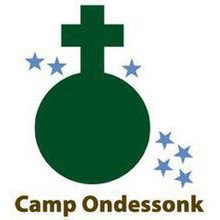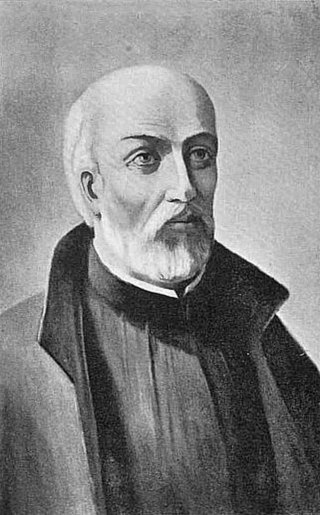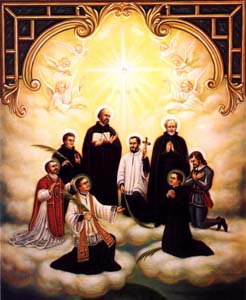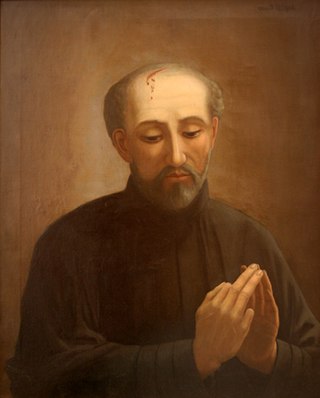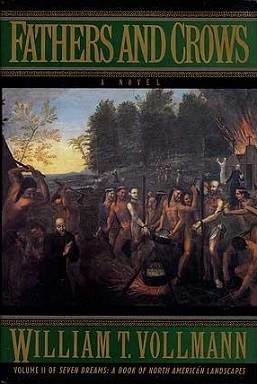History
Camp Ondessonk started as a summer program in 1957. Known as Camp St. Philip, [5] the program is part of the Diocese of Belleville. Having no facilities of their own, camp administrators rented out Camp Piasa [6] in Grafton, Illinois in 1957 and Camp Vandeventer in Waterloo, Illinois in 1958. Each summer, the camps were staffed by seminarians and college students all under the direction of Monsignor John T. Fournie.
Camp St. Philip offered participants outdoor activities such as riflery, archery, swimming, and handicrafts, as well as other activities such as cooking, housekeeping, and axmanship. The camp also offered a camping honor society. Campers at St. Philip spent their nights in one of five units; Marquette, LaSalle, Lalande, Brebeuf, and Hennepin.
Led by a desire for a permanent location for a Catholic youth camp, Monsignor Robert DeGasperi oversaw the effort to gain leases of the land that would become Camp Ondessonk. [7] Volunteer crews began construction at the current site in the spring of 1959. 481 campers and 52 staff attended over a four-week period that the camp was open. Campers were grouped into four units – Brebeuf, Chabanel, Goupil, and LaLande. Activities included swimming, archery, riflery, horseback riding, nature hikes, and camp crafts.
In the 1960s, additional camping weeks were added to the schedule because of demand. More space was added with the construction of more units - Daniel, Garnier, Tekakwith, Amantacha, Ahatsistari and Lalemant. Some units were tents while others were cabins. An adventure program was based in the unit of Teondecoren. The swimming lake – Lake St. Isaac – was added as well as Lake Echon, a separate lake for watercraft. A bridge was built over Lake Echon and was dedicated to the memory of Larry Garner, a former staff member who was killed in action in Vietnam. Awards in the form of arrowhead-shaped patches were added for skills mastery for the various activities. Pioneer sessions were introduced in 1965 to give campers a more in-depth experience through a two week program. [5] The Pioneer Sessions led to the formation of Frontier Units in the 1970s. Although they were referred to as units, the Frontier program was a separate experience from camp, during which participants traveled to places offsite. [5]
In the late 1970s the Silver and Golden Frontier Program was added. [5] Inspired by the original Frontier units, the Silver and Golden Frontier trips catered to adults wishing to travel around the country.
To help with the expanding interest, Ahatsistari and Lalemant were built as cabins in order to accommodate more campers. The camp program was expanded to include an all-day exploration to give the campers the chance to explore the land around them. A marathon competition was added as well. The Garnier tree houses were built up shore from the original cabins and the Amantacha bridge was added to replace the various methods of getting campers across Lake Echon. Chabanel was moved to its current location in 1979.
The Lalande cabins were rebuilt into tree houses in 1981. Other units were rebuilt in this period as well. A new barn was added in 1983 and a new health center was added in 1986. By 1989 the units of Teondecoren and Ahatsistari were no longer available to campers as a unit choice. Coed sessions were added in 1989.
Specialty Camps were introduced in the summer of 1992. In 1995, Teondecoren was reintroduced as a tepee unit for one summer. In 1996, the camp was accredited by the American Camping Association (later renamed the American Camp Association). A minicamp program was introduced for younger campers in 1999.
Camp Ondessonk was also accredited by the Certified Horsemanship Association in 2003. [8] A new dining hall was opened for the summer of 2004.
Facilities
Units
Most campers stay in cabin groups called units. [40] There is no electricity in most of the units. Each unit has potable water, an outhouse and campfire ring.
Units are one of four designs - tree house, cabin, cave or A-frame. [41] Tree house units have 3 walls and an open entrance with catwalks connecting the cabins. The cave unit consists of platforms on the ground with no walls (two tree house style buildings are also in this unit). The A-frame unit has three buildings with screened in windows and doors. There are two different styles of cabin units.
| Unit Name | Unit Type | Unit color | Spirit Animal | Musician Cabins Are Named After | Notes |
|---|
| Amantacha | Tree House | Forest Green | Swallow | Grateful Dead | |
| Brebeuf | Cabins | Royal Blue | Raccoon | Simon and Garfunkel | One of the original four units. |
| Chabanel | Cave | Golden Yellow | Bear | Jethro Tull | One of the original four units. |
| Daniel | Tree House | Black | Eagle | The Beatles |
| Garnier | Tree House | Kelly Green | Bobcat | Led Zeppelin |
| Goupil | Tree House | Purple | Fox | Bob Dylan | One of the original four units. |
| Lalande | Tree House | Red | Owl | Tom Petty | One of the original four units. |
| Lalemant | Tree House | Orange | Beaver | The Doors | |
| Raganeau | Tree House | Turquoise | Squirrel | Pink Floyd | The oldest standing unit. |
| Tekakwitha | A -Frame Lodges | Light Blue | Deer | (Named after Native American Tribes) | Fully enclosed. |
| Chiwatenwha | 4 Sided Cabins | Light Green | Turtle | Fleetwood Mac | Fully enclosed. |
| Aonetta | 4 Sided Cabins | Pink | Hummingbird | Fleetwood Mac | |
Other campsites
| Unit Name | Unit Type | Unit Color | Spirit Animal | Notes |
|---|
| Ahatsistari | Cabins | Light Brown | Rabbit | Originally a tent unit, cabins built later, then repurposed as an activity area |
| Couture | Tent | Light Blue | Butterfly | Various Locations; Lower Pakentuck, near main area, along Camp Road |
| Teondecoren | Tree house | Tan | Pheasant | Various iterations in the camp's history noted below |
Teondecoren and Couture were originally designated as primitive units that gave campers an experience away from camp during which they lived off the land for the week. Teondecoren was later made into a tree house unit in 1973, then as a tepee unit in 1995. Couture was a tent unit as needed based on session enrollment. [5]
Other sleeping areas
BOQ - officially Bachelor Officers' Quarters [42] but colloquially called "boys only quarters," though it can be used for campers and staff, male or female. This building is a fully enclosed cabin at group level and has electricity.
Lakeside - consists of a long bunkhouse style cabin as well as two smaller cabins.
Frontier Dorms - fully enclosed bunkhouses.
St. Noel - year-round lodging and retreat center.
Administrative facilities
The dining hall is a modern facility that can serve all of camp at one time. The building is heptagonal and has a fireplace in the center. It is located away from main camp, on top of the same hill as the stables. Most meals are served family style. The dining hall is air conditioned, and has windows on all sides to allow for ventilation. It is decorated with art work depicting camp that was created by current and former staff members as well as friends of camp. The dining hall had air conditioning installed for the summer of 2013.
The Health Center is equipped to handle guests throughout the year. It is staffed by medical professionals and on-call pediatric physicians every day of the summer. This facility has air conditioning. [43]
The Old Dining Hall is still used for various programming including breakfast on the last day of each summer session and as a rainy day location.
The Trading Post sells food and items such as toiletries, camp gear, camp paraphernalia, ice cream and candy.
The St. Noel Lodge hosts the administrative offices of the camp and is also used for guest lodging year-round.
Natural areas
Pakentuck is a natural area that includes a waterfall and the remnant of a Boy Scout camp. Cedar Falls is the largest single, free-flowing waterfall in Illinois. [44] The Pakentuck name comes from a Boy Scout group from Paducah, Kentucky.
Lake Echon drains via a small waterfall known as the Spillway. Formerly known as St. Catherine falls after St. Kateri Tekakwitha who took St. Catherine of Siena as her patron when she was baptized. [29]
Split Rocks are common hike destinations. One of the split rocks is Augustine's Agony. Some others are Big Split, Little Split and Fat Man's Misery.
Hogg's Bluff is natural, stone peak jutting high above a lake. It was allegedly used as a trading post for Native Americans. [45]
Bush's Garden is swimming hole downstream from the Spillway, popularized by a counselor with the last name Bushong, nickname Bush.
Cannonball Rock is a boulder in a stream that is popular for cannonball and other jumps into the water.
Pine Lake and Kane Lake are locations for swimming and camping.
Phantom's Canyon is near the west camping areas.
Program areas
Program areas include an archery range, riflery range, handicrafts building, stables for horseback riding, a boating area for canoeing and kayaking, a swimming lake, a chapel, and other outdoor clearings for other programs such as woodsmanship. [46] Many of the natural areas noted above are visited during daytime and overnight hikes.
Evenings include campfires, large group games, camping out overnight away from units, and an honor society ceremony. [47] The first and last evenings of the summer program are held under a natural grotto. Mass is celebrated on Sunday evening during the summer program.
Lodge of Ondessonk and Tekakwitha
The Loyal Lodge of Ondessonk and Tekakwitha are modeled after the honor camping society first established during Camp St. Philip in 1957. [50] Induction into Lodge is open to campers, staff, and volunteers who demonstrate loyalty and dedication to camp in an exemplary way, and takes place each Thursday night during the summer in the Lodge ceremony. In order to be considered for Lodge, candidates much show these qualities as well as being at least a second year camper or staff member. Participants of both traditional camp and adventure programs are eligible. Members are divided geographically into councils for administrative purposes to give back to Ondessonk through fundraisers or service. Members of Lodge may also attend Fall and Spring Lodge Reunions each year. A member of Lodge is signified by a sash they wear, containing a patch of a simplified version of the symbol of Camp Ondessonk. General members wear red and blue sashes. Both are more simply referred to as Lodge members.
After being absent since the 1970s, the Lodge arrowhead was reestablished in 2007 and can be earned by Lodge members over time through dedication to Lodge. There are also two other honors awarded by the Lodge of Ondessonk and Tekakwitha. The St. John de Brebeuf Award is given to an active or associate member for rendering meritorious service to Camp Ondessonk, the Lodge service organization, and the community. The John de LaLande Award is presented to a non-Lodge Member who is part of the Camp Ondessonk staff and feels that they do not meet the proper requirements for membership into the organization but have rendered meritorious service to Camp Ondessonk and the community.
Lodge camp
Lodge Camp allows campers to participate in traditional camp members with fellow Lodge members. [47] Campers stay in a unit made up of other Lodge members and led by a Lodge Official on staff. As part of their experience Lodge Campers participate in rock climbing at Pakentuck, the High Challenge Course, and an extended horseback ride. They also perform a service project for Camp. Campers must be a member of the Loyal Lodge of Ondessonk and Tekakwitha in order to be eligible to attend. The program is open to campers meeting this requirement ages 11–16.
Lodge trips
Beginning in the mid-1960s, Camp Ondessonk began organizing trips to destinations around the world as a reward for members of the Lodge of Ondessonk and Tekakwitha who sold specific quotas of advertisement space for the annual yearbook. [50] Members were notified by a letter inviting them to participate free-of-charge. The trips took place over the Christmas holidays and went to places like Europe, Africa, and the Bahamas. They were usually 10 to 14 days long. In 1964 the trip left from Miami, Fl., on a yacht and sailed to the Bahama Islands for a Christmas vacation of swimming, beach combing, shopping, and relaxation. The 1971 trip took participants on an Iberian tour through Spain, Portugal, and Morocco. During one Lodge trips, which was in 1968 and went to Italy and Switzerland, the group attended Christmas Mass with the Pope and sat in ambassador seats just 20 feet from the Pope. They also spent New Year's Eve in Venice. The 1970 trip scheduled to tour the Middle East was canceled due to conflict in the region. The trips were eventually discontinued.
Legal issues
On July 7, 1981, a camper received a minor wound on his hand when he reached into Tommy the Bear's cage during feeding time and grabbed at Tommy's ears. [5] The camper was treated by health services at camp, but the wound later became infected. A court ordered Tommy to be examined for rabies but this could only be accomplished by killing the bear so that his brain tissue could be examined. This court order was appealed and after multiple legal proceedings, the injured camper's family dropped the lawsuit. [54]
An Albuquerque man filed a lawsuit alleging that he was sexually abused by a former director while he was a camper in 1981. [55] The camp and the Diocese of Belleville were eventually dismissed in the district court. [56]
A lawsuit was filed for negligence against the camp for not properly safeguarding a cliff after an accident on 10 April 1992. A district court granted summary judgment to the Catholic Diocese of Belleville. The case was appealed and the decision in favor of the Catholic Diocese of Belleville was affirmed. [57] [58]
